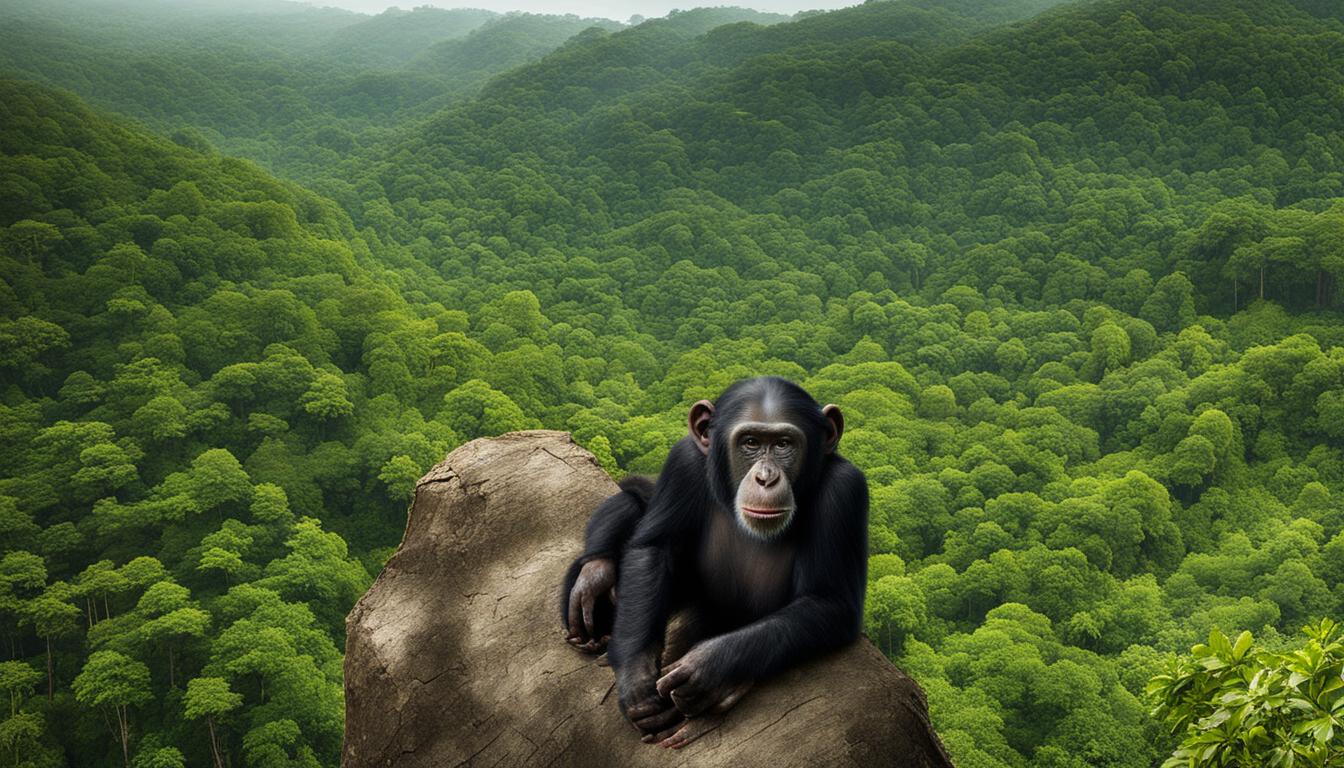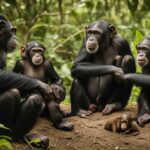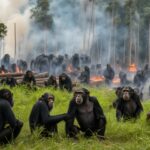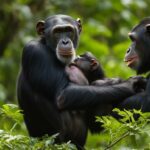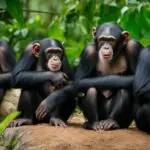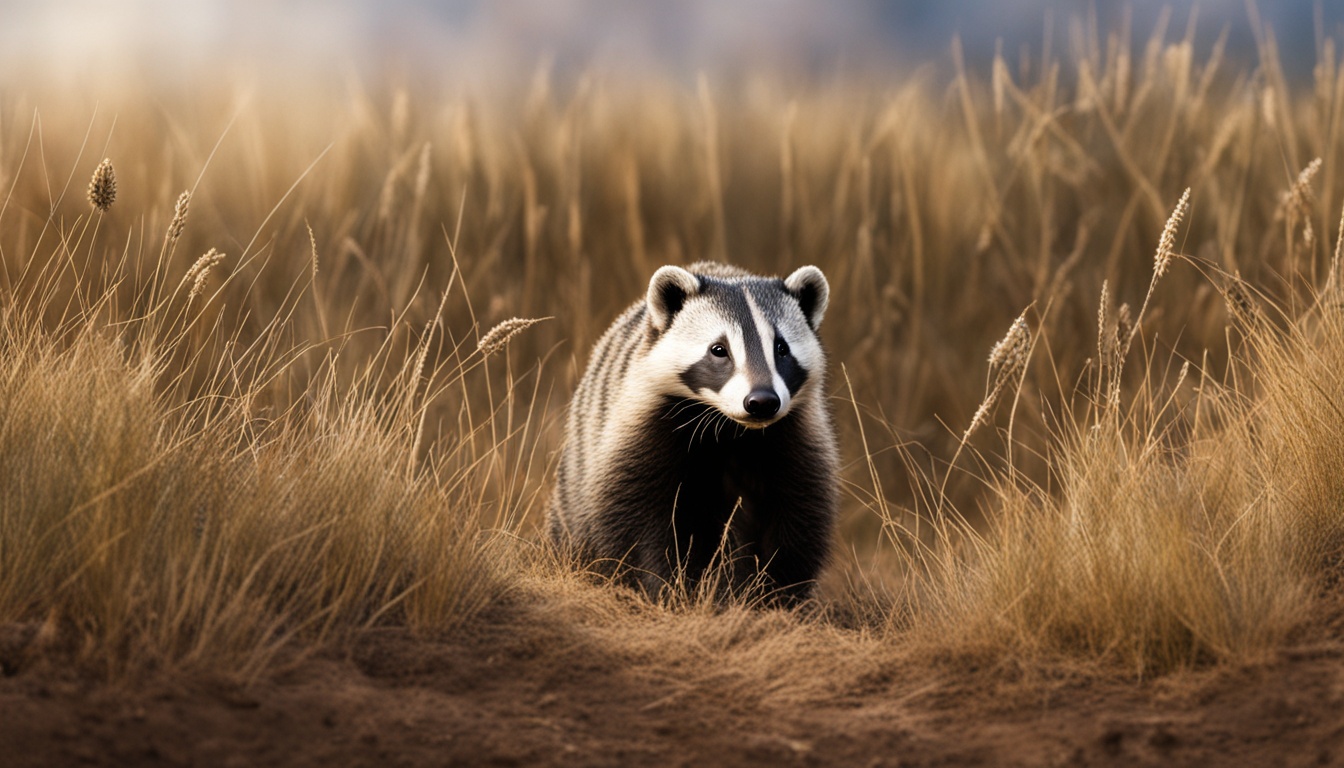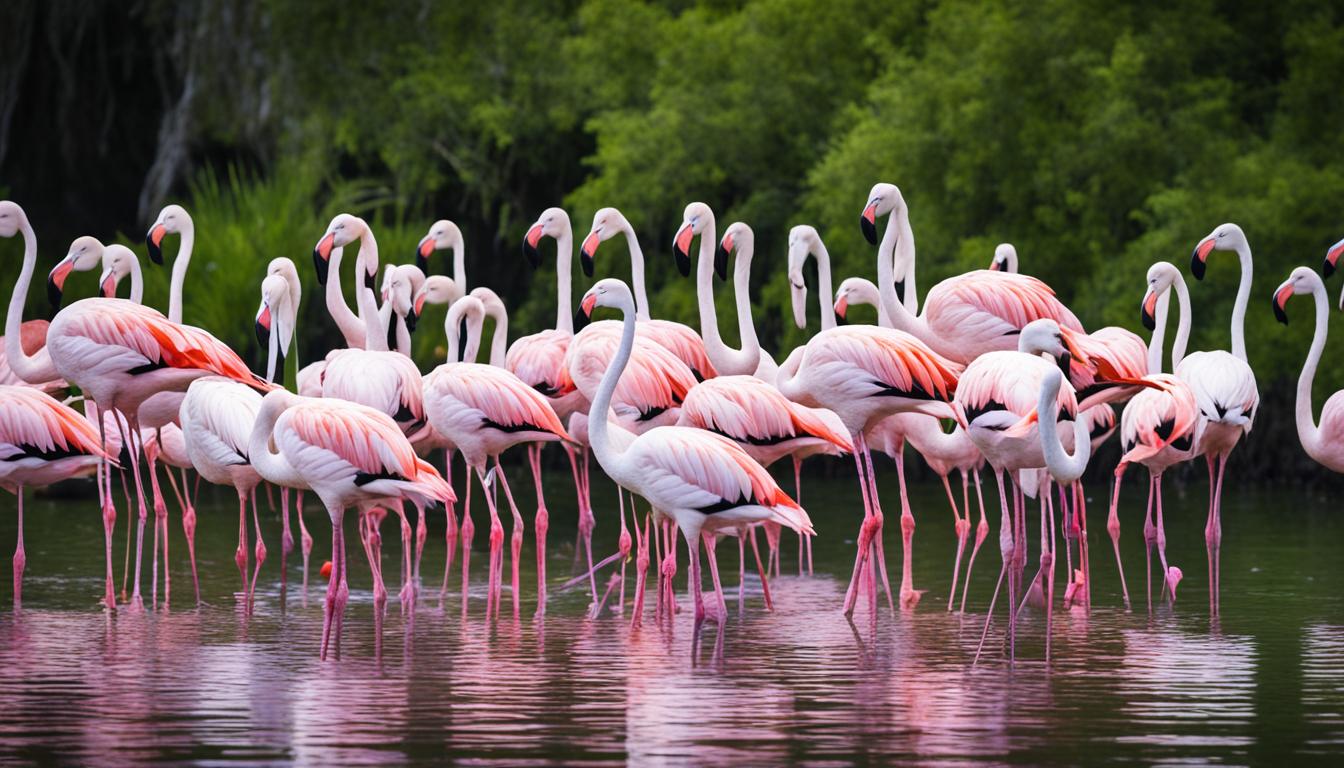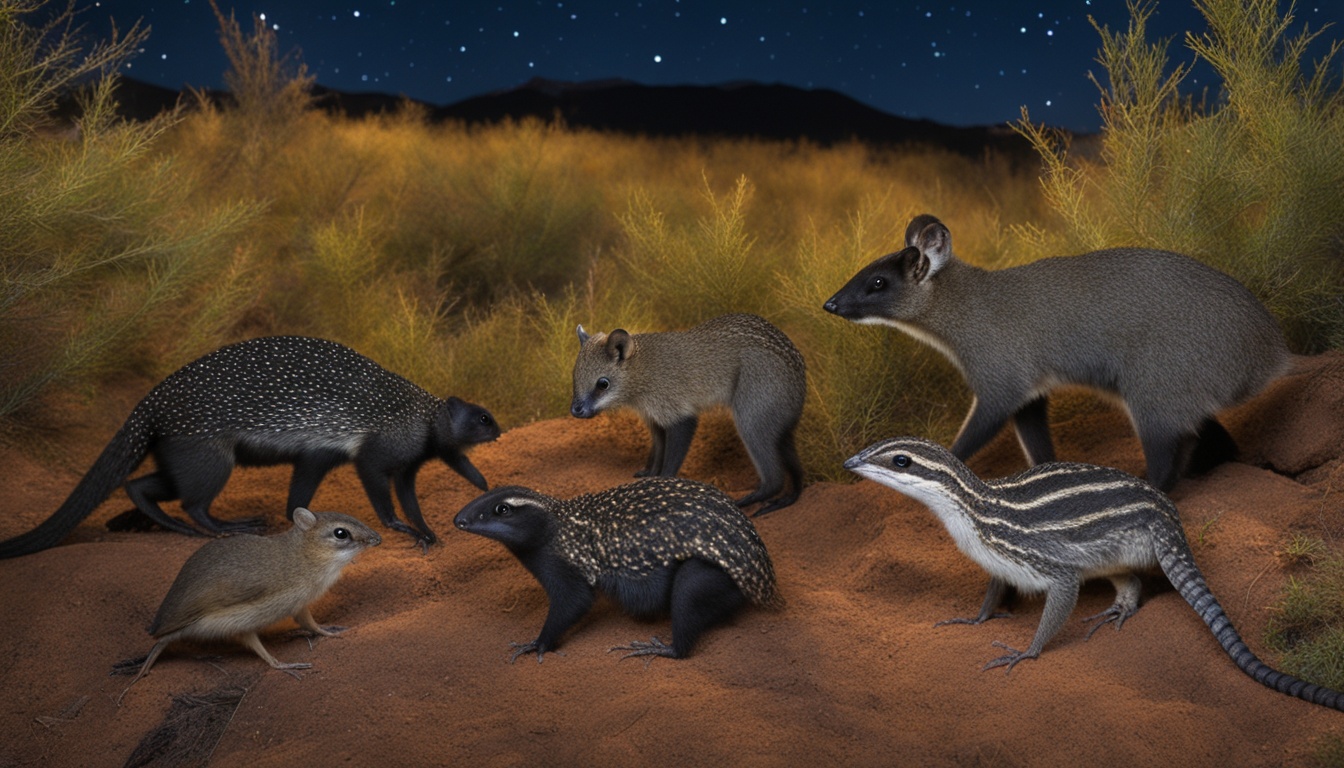Habitat loss is having a significant impact on wild chimpanzee populations. Chimpanzees are found in a variety of habitats, including savanna woodlands, grassland-forest mosaics, and tropical moist forests. They play a vital role in maintaining the diversity of Central Africa’s forests. However, their populations are threatened by habitat loss, disease, and hunting, particularly for bushmeat. Conservation efforts are underway to protect chimpanzees and mitigate the declining populations caused by habitat destruction.
Social Structure and Behavior of Chimpanzees
Chimpanzees are highly social creatures, living in fusion-fission societies that consist of loose and flexible groups. At the helm of these groups is a dominant male, leading and guiding the community. However, it’s important to note that other groups with varying levels of authority may also exist within the chimpanzee community.
Chimpanzees have a unique breeding cycle, with females giving birth to one or two offspring approximately every 5-6 years. This slow reproductive rate contributes to the conservation efforts dedicated to protecting these incredible primates.
Did You Know? Chimpanzees have a diverse diet, which includes fruits, leaves, insects, and occasionally meat. Their varied eating habits play a crucial role in maintaining the delicate balance and biodiversity of Central Africa’s forests.
Unfortunately, chimpanzee populations are under threat from various factors, including habitat loss, disease, and hunting. As a result, extensive conservation efforts are being implemented to safeguard chimpanzees and their habitats.
Range and Distribution of Chimpanzees
Chimpanzees have a wide range of habitats, including the Congo Basin, which is a priority area for their conservation efforts. These remarkable primates are distributed across several range states in Central and West Africa, including Angola, Cameroon, Democratic Republic of the Congo, and Uganda, among others.
Chimpanzees primarily inhabit the biogeographic realm of Afrotropical and are found in various ecological regions, such as Guinean Moist Forests and Central Congo Basin Moist Forests. Their adaptability allows them to thrive in diverse environments, including savanna woodlands, grassland-forest mosaics, and tropical moist forests.
Protecting these habitats is crucial for the survival of wild chimpanzee populations. Given their extensive range and distribution, efforts must be made to preserve and restore these biologically rich areas to ensure the long-term survival of these iconic primates.
| Range States | Biogeographic Realm | Ecological Region |
|---|---|---|
| Angola | Afrotropical | Guinean Moist Forests |
| Cameroon | Afrotropical | Central Congo Basin Moist Forests |
| Democratic Republic of the Congo | Afrotropical | Guinean Moist Forests Central Congo Basin Moist Forests |
| Uganda | Afrotropical | Guinean Moist Forests |
Threats to Chimpanzee Habitats
Habitat loss poses a significant threat to the survival of chimpanzees in the wild. Primarily driven by deforestation resulting from human activities such as logging and agricultural expansion, these destructive practices are devastating chimpanzee habitats. This rampant habitat loss further leads to fragmentation, where the remaining patches of forest become isolated and disconnected, limiting the resources available to chimpanzee populations.
The encroachment of human activities into chimpanzee habitats not only destroys their homes but also heightens the vulnerability of these magnificent primates. As their natural habitats dwindle, chimpanzees face increased competition for limited resources and spaces, making it more challenging for them to find food, shelter, and suitable breeding grounds. Moreover, the disturbance caused by human activities and habitat fragmentation disrupts their social structures and behaviors, further jeopardizing their survival.
Another threat to chimpanzee habitats is the escalating human-wildlife conflict. As humans continue to encroach upon their territories, conflicts arise, leading to direct harm to chimpanzees. This conflict increases the risk of injury and mortality, and can even aggravate hunting practices, which pose a significant threat to chimpanzee populations.
To safeguard the future of chimpanzees and mitigate the threats they face, extensive conservation efforts are underway. These efforts focus on protecting and restoring chimpanzee habitats, implementing measures to reduce deforestation and habitat fragmentation, and promoting sustainable practices that harmonize human activities with the needs of chimpanzee populations.
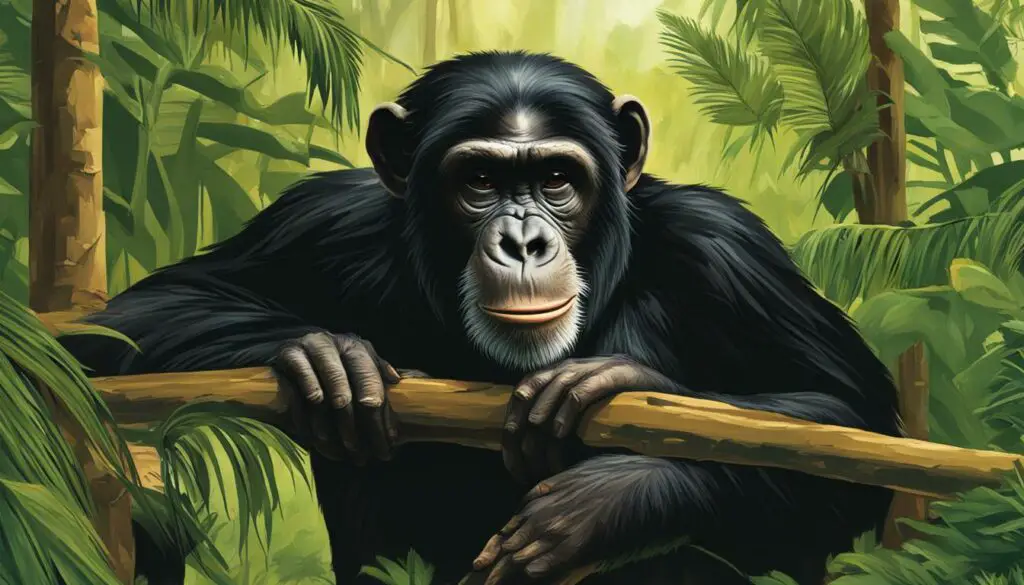
The image above illustrates the devastating impact of habitat loss, underlining the urgency to address this critical issue.
Impact of Habitat Loss on Chimpanzee Populations
The impact of habitat loss on wild chimpanzee populations is significant. As habitats are destroyed and fragmented, the available resources and space for chimpanzees are reduced. This habit loss leads to population decline and increased susceptibility to threats such as disease and hunting. Habitat fragmentation also disrupts social structures and behaviors, as chimpanzees are forced to adapt to smaller and more isolated territories. Furthermore, human-wildlife conflict further exacerbates the challenges faced by chimpanzees, jeopardizing their chimpanzee survival.
Conservation Efforts to Mitigate Chimpanzee Population Decline
Conservation efforts are vital in reducing the declining population of chimpanzees. Various strategies are being implemented to protect these incredible primates and their habitats, including:
- Habitat Protection and Restoration: It is crucial to safeguard chimpanzee habitats from further destruction caused by deforestation and human activities. By preserving and restoring these habitats, we provide chimpanzees with the necessary resources and space for their survival.
- Anti-Poaching Measures: To combat the illegal hunting and trade of chimpanzees, anti-poaching measures are being enacted. These efforts aim to enforce wildlife protection laws, dismantle poaching networks, and strengthen penalties for those engaged in such activities.
- Raising Awareness: Many organizations are working tirelessly to raise awareness about the importance of chimpanzee conservation. Through education programs and campaigns, both children and adults are being informed about the vulnerability of chimpanzees to hunting and the significant role they play in maintaining healthy ecosystems.
Collaboration between organizations, local communities, governments, and other NGOs is essential for the success of these conservation efforts. Together, we can protect chimpanzees and ensure the long-term survival of these remarkable creatures.
Conclusion and Future Outlook
The impact of habitat loss on wild chimpanzee populations is significant and poses a grave threat to their survival. As human activities continue to encroach upon their habitats, chimpanzees are facing shrinking territories and limited access to vital resources.
However, there is hope for the future of these iconic primates. Conservation efforts are underway to mitigate the effects of habitat loss and protect chimpanzee habitats. By focusing on habitat preservation and restoration, implementing robust anti-poaching measures, and fostering greater awareness about the importance of chimpanzee conservation, we can make a positive difference.
Collaboration between stakeholders, governments, and local communities is crucial in ensuring the long-term survival of wild chimpanzee populations. Together, we can create a future where these intelligent and enigmatic creatures thrive in their natural habitats.
The road ahead may be challenging, but with our concerted efforts, we can safeguard the future of wild chimpanzees and preserve the delicate balance of our ecosystems.
Are Habitat Loss and Chimpanzee Tourism Equally Impacting Wild Chimpanzee Populations?
Habitat loss and chimpanzee tourism impact and conservation are both contributing to the declining wild chimpanzee populations. Deforestation and human encroachment are shrinking their natural habitats, while tourism activities disrupt their behaviors and habitats. Both factors require immediate attention and conservation efforts to protect the future of chimpanzee populations.
Are Wild Chimpanzee Populations Also Being Affected by Habitat Loss in a Similar Way to Gorilla Populations?
Wild chimpanzee populations are indeed being affected by habitat loss in a similar way to gorilla populations. As their natural habitats are being destroyed for agriculture and development, both species are facing a decline in numbers. Conservation efforts are critical to protect the habitat loss and gorilla populations.

